Don’t confuse Trump’s tax cuts with tax reform
Loading...
Have you noticed the subtle reframing of Donald Trump’s tax plan? During the campaign, it was a huge tax cut. Now, Trump and his congressional allies are transforming it into the far less controversial “tax reform.” After all, while a tax cut may be dubious when the economy is growing moderately and the budget deficit tops $587 billion, who could be against tax reform?
But don’t be fooled by those who call the Trump plan reform. While it may include some random elements of reform, it would firmly retain the basic structure of today’s code. At heart it is merely a giant tax cut designed to benefit mostly businesses and high-income households.
What’s the difference? Well, a tax cut is pretty obvious. But what is tax reform, a phrase that broadly defines many different ideas?
There is the 1986 model, which cuts tax rates while reducing or eliminating tax preferences—often described as the lower-the-rates, broaden-the-base prototype. Then, there are the many ways to shift to, or at least towards, a consumption tax. They come in many varieties and with many names, such as value-added taxes, cash-flow taxes, national sales taxes, and business transfer taxes. But all share the common characteristic of reducing or eliminating taxes on savings while taxing spending.
What has Trump proposed? Because his tax ideas are both vague and constantly evolving, it is hard to really know. But while his latest version seems to include bits of both versions of reform, it really looks much more like a plain old tax cut—only bigger than what we are used to seeing. The Tax Policy Center estimates that Trump would cut taxes by $6.2 trillion over the next decade. But don’t make the mistake of confusing ambitious with reform.
He is not proposing a consumption tax. True, by allowing firms the option of immediately expensing the cost of capital investment (and giving up the ability to deduct interest costs), Trump would dabble with a key element of business cash flow tax. But Trump is just dipping his toe in these waters, in stark contrast to the more comprehensive versions many of his GOP primary challengers offered. On the individual income tax side, Trump does nothing to shift to a consumption-type tax.
What about reform by broadening the base and lowering the rates? Well, there is little doubt that Trump has fully embraced the easy half of that formulation. He certainly wants to lower tax rates for businesses and most individuals. But when it comes to the hard part—cutting tax deductions and credits to offset the cost of those rate cuts—Trump doesn’t come close.
On the business side, Trump does not identify a single tax preference that he would eliminate (other than the voluntary swap of the interest deduction for expensing). His late-campaign plan promised to eliminate “most corporate tax expenditures” but he never said what they were. And in some ways, Trump may be headed in just the opposite direction. For instance, a few weeks ago two of his economic advisers suggested new tax credits to encourage businesses to invest in infrastructure.
Similarly, Trump did not identify a single individual income tax preference that he’d eliminate or scale back. He did say he’d limit the ability of hedge fund operators and others to treat compensation as capital gains instead of ordinary income. And he vowed to cap itemized deductions. But he also proposed creating both a new deduction and a new tax-favored savings account for child and dependent care costs and expanding the credit for employer-provided child care. This seems more like shuffling the base than narrowing it.
And what of the House Republican tax plan—House Speaker Paul Ryan’s “Better Way?” It too is something of a mixed bag though it is closer to something called reform. By cutting tax rates and promising to eliminate most tax deductions, it includes elements of a 1986-like rewrite. By eliminating expensing and the related deduction for interest costs and cutting taxes on investment income, it includes hints of a consumption tax. But mostly it too is a very big tax cut—though not quite as grand as Trump’s. TPC’s estimates the House GOP plan would cut taxes by $3.2 trillion over the next decade. If it walks like a duck….
Beware the next time you hear politicians throw around a phrase like “tax reform.” Pay more attention to what they propose than what they call it.
This story originally appeared on TaxVox.







